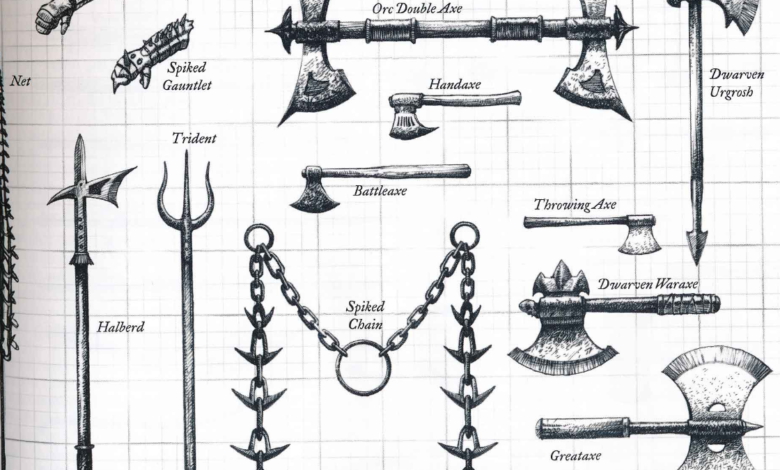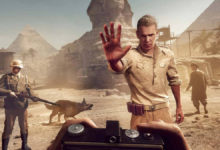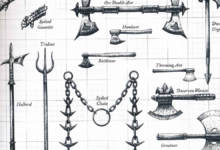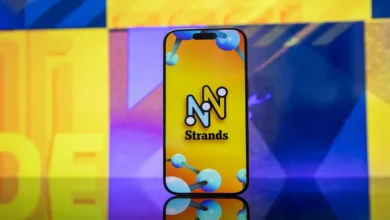Mastering DnD Weapons: A Complete Expert’s Guide

If you’re diving into the rich world of Dungeons & Dragons, understanding the complex and creative realm of DND weapons is essential. Whether you’re a player looking to optimize your build or a Dungeon Master crafting legendary loot, weapons in D&D offer more than just a means to deal damage—they define styles, strategies, and stories.
From the glinting longswords of noble paladins to the crudely-forged greataxes of raging barbarians, every weapon in D&D has character. They’re not just tools—they’re symbols, tactics, and often, the first thing a player imagines when designing their hero (or villain).
Let’s explore this enchanting and deadly topic in full detail, from weapon types and stats to customization, iconic examples, and expert advice on making the most of your armory.
Understanding the Core Types of DnD Weapons
DnD weapons come in a variety of types and categories, each with its unique stats, properties, and purposes. These aren’t just for flavor—they impact the mechanics of combat, tactics on the battlefield, and even your character’s personality.
Simple vs Martial Weapons
Weapons in D&D are broadly classified into two categories: simple weapons and martial weapons. The distinction isn’t just for show—it directly affects who can use them effectively.
Simple weapons are just that—simple to use. These are weapons that most classes, even those not trained in combat, can pick up and wield. Think clubs, daggers, and slings. They’re great for spellcasters who may only need a weapon as a backup.
On the other hand, martial weapons are more advanced and usually require specialized training. These include weapons like longswords, battleaxes, and longbows. Martial weapons offer more versatility and power, but they’re typically reserved for fighter-type classes.
Choosing between simple and martial depends on your class proficiencies. But it also depends on your narrative. Maybe your bard was a street brawler—clubs and daggers make sense. Or perhaps your monk was trained in secret martial traditions—perfect for a quarterstaff or spear.
Melee vs Ranged Weapons
Another major distinction is melee vs ranged weapons. Melee weapons are used in close-quarters combat—ideal for the frontline fighter or rogue who likes getting up close and personal. Ranged weapons, meanwhile, are great for characters who prefer to strike from afar—archers, spell-wielding warlocks, or even sneaky rogues with crossbows.
Interestingly, some weapons can blur the line. Take the spear—it can be thrown or used in melee. Or consider the versatile quarterstaff, which can be wielded one-handed or two-handed depending on your combat needs.
This flexibility is where DnD weapons shine. They aren’t confined to boxes. Your weapon choice reflects your combat philosophy, not just your damage output.
The Most Iconic Weapons in DnD
Dungeons & Dragons has a long and legendary history, and over the decades, some weapons have risen to iconic status. Whether through powerful lore, infamous players, or mechanical popularity, these DND weapons have become staples in many campaigns.
The Longsword
Ah, the longsword—the weapon of heroes, kings, and classic fantasy knights. In D&D, the longsword is a versatile martial melee weapon that can be wielded with one or two hands. This versatility makes it a popular choice for fighters and paladins alike.
Mechanically, the longsword deals 1d8 slashing damage, or 1d10 when used with two hands. It’s not flashy, but it’s reliable. And when enchanted or customized, it becomes something more than a basic blade—it becomes a legacy.
In a roleplaying context, the longsword often represents discipline and honor. Maybe it’s a family heirloom, passed down through generations. Or perhaps it was looted from a vanquished foe. Either way, the longsword is D&D royalty.
The Greatsword
For those who believe the best defense is a brutally overwhelming offense, the greatsword is the ultimate statement. It’s a two-handed martial weapon that deals a whopping 2d6 slashing damage—and with the “heavy” and “two-handed” properties, it’s built for the beefiest warriors.
Barbarians, especially, love this weapon. Pair it with Great Weapon Master and Reckless Attack, and you’re looking at devastating critical hits and serious damage output.
But beyond its mechanics, the greatsword has dramatic flair. It’s a big weapon for big moments. When a character draws a greatsword, you know they mean business.
Weapon Properties Explained: What They Actually Mean
One of the things that make DnD weapons interesting is their properties. These aren’t just technical notes—they’re tactical options that affect how you fight. Let’s break down some of the most common ones and what they mean in practice.
Versatile
A versatile weapon can be used with one hand or two. This is perfect for characters who want to wield a shield sometimes, but also want the option of dealing extra damage when they go all in. Weapons like the longsword and warhammer have this property.
This flexibility can be key during combat. Switch to two hands when you need to push damage. Grab your shield when defense becomes a priority. It’s a smart option for adaptive players.
Finesse
Finesse weapons allow you to use your Dexterity modifier instead of Strength for attack and damage rolls. This is crucial for classes like rogues and monks who want to maximize their agility.
Weapons like the rapier, dagger, and shortsword fall into this category. They’re not just good for sneak attacks—they’re the backbone of high-DEX combat.
Finesse weapons also tend to be light, fast, and perfect for dual-wielding, making them a must-have for characters who like speed over brute force.
Reach
Reach weapons increase your attack range by 5 feet. Sounds minor? Not when it lets you stay out of harm’s way or control a chokepoint. Weapons like the glaive, halberd, and whip have this property.
If you want to play a battlefield tactician—someone who controls movement and positioning—reach weapons are your best friends.
Magical DnD Weapons and How to Handle Them
No conversation about DnD weapons is complete without diving into magical arms. In D&D, magic weapons are a treasure trove of possibility—and often the stuff of legends.
What Makes a Weapon Magical?
At its simplest, a magic weapon has a bonus to attack and damage rolls (+1, +2, +3). But that’s just the beginning. Magic weapons can slay specific enemies, shoot fire, return when thrown, or even hold a sentient personality.
Some legendary weapons can grow with you—like the Holy Avenger for paladins, or the Vorpal Sword that can literally decapitate enemies on a critical hit.
When handling magic weapons, remember to balance their power. Dungeon Masters should avoid handing them out like candy. Make them rare, mysterious, and meaningful. Players, meanwhile, should treat them as prized possessions—not just numbers on a sheet.
Crafting and Customization
Want your own magic weapon? In many campaigns, you can forge or enchant one through quests, spellcasting, or downtime activities. This adds a layer of immersion and ownership.
Maybe you track down rare materials from a volcano to forge a flame sword. Or convince a master blacksmith to reforge your broken blade into something mighty. These stories become just as meaningful as the loot itself.
Best Weapons for Each DnD Class
Every class has a weapon that fits both mechanically and narratively. Let’s explore how weapon choices vary between classes.
Fighter
Fighters are weapon masters, with proficiency in basically everything. Greatsword, longsword, polearm—you name it, they can use it. Pick your fighting style and match your weapon accordingly. Great Weapon Fighting synergizes beautifully with two-handers.
Want to dual wield? Grab two shortswords. Prefer defense? A sword and board setup (sword + shield) works wonders. Fighters get multiple attacks—so pick weapons that scale well with multiple swings.
Rogue
Rogues thrive with finesse and light weapons, like daggers and rapiers. Why? Because Sneak Attack only works with finesse or ranged weapons. Pair this with Cunning Action, and you have a slippery, deadly combatant.
Crossbows can also work for a ranged rogue. But don’t overlook the dagger—its versatility makes it a top-tier rogue weapon.
Paladin
Paladins are flavorful and divine, and their weapons reflect that. Many paladins opt for longswords, warhammers, or mauls—often enchanted or blessed. Their Divine Smite ability makes every hit count, so pick weapons that maximize your crit range.
You can also theme your weapon with your Oath. A vengeance paladin might carry a blackened blade. A devotion paladin might wield a gleaming warhammer.
(Continues in next message)
(Continuing the long-form article on “dnd weapons”)
Monks, Wizards, and Other Unusual Weapon Users
Not all classes rely on brute strength or martial prowess to shine with weapons. In fact, some of the most creative weapon builds in DnD come from unexpected places.
Monk
Monks are martial artists, and their weapon choices reflect that aesthetic. While they mostly rely on unarmed strikes, monks are also proficient with monk weapons—simple melee weapons that don’t have the heavy or two-handed property.
Weapons like quarterstaffs, spears, and shortswords fit here, and they synergize with monk abilities like Martial Arts and Flurry of Blows. The key is speed, fluidity, and spiritual flair. A monk with a quarterstaff is essentially channeling ancient kung fu vibes.
Wizard
Wizards don’t need weapons, right? Well, kind of.
Most wizards don’t bother swinging a sword when they can drop a Fireball, but some builds—like the Bladesinger in the Sword Coast Adventurer’s Guide—can make weapon-based wizardry a real thing.
These magical warriors might use rapiers, scimitars, or even staves to cast spells while engaging in melee. It’s a risky but stylish way to play.
And don’t forget that magic staves and wands often are weapons—they just don’t look like them.
Exotic and Rare DnD Weapons You’ll Love
If you’re bored with swords and spears, don’t worry—DnD weapons get wild when you dive into exotic, homebrew, and setting-specific options.
Whips, Nets, and Spiked Chains
Some weapons are about more than damage. Whips, for instance, have reach and can be used to trip, disarm, or entangle enemies. While the damage isn’t great (1d4), they offer a level of tactical control.
Nets are often misunderstood. They don’t deal damage but restrain enemies—a powerful status effect that can tilt a fight. They’re tricky to use, but under the right conditions, devastating.
Spiked chains, often introduced in homebrew or older editions, mix flavor with utility. Imagine a rogue or warlock swinging one around like a gothic superhero. Yes, please.
Setting-Specific Weapons
Playing in Eberron? You might find arcane firearms or warforged weapon-fusions. Running a Dark Sun campaign? You’ll find bone weapons, obsidian blades, and sand-forged daggers.
These weapons reflect the world they come from—and they make your character feel part of it.
Don’t be afraid to ask your DM for custom weapons that match your backstory. A jagged pirate cutlass. A frost-covered hammer passed down by dwarves. Make it personal.
Dual-Wielding, Shields, and Weapon Combinations

One of the most exciting aspects of DnD combat is how you combine weapons—not just picking one and swinging it every turn.
Dual-Wielding
Dual-wielding is a fan-favorite. There’s something inherently badass about having a weapon in each hand. Mechanically, it lets you make a bonus action attack with your off-hand weapon, assuming it’s light.
The downside? You can’t use a shield. And unless you take the Two-Weapon Fighting style or the Dual Wielder feat, you’ll miss out on ability modifier damage for your off-hand.
Still, for rogues, rangers, or dex-based fighters, it’s stylish and effective. Think twin daggers. Or short swords. Or maybe a scimitar and dagger combo for that exotic flair.
Weapon + Shield
If you prefer a defensive playstyle, pairing a one-handed weapon with a shield is a classic move. Shields provide a +2 AC boost, which can be a game changer.
Classes like paladins and clerics thrive with this setup. Combine it with spells like Shield of Faith, and you become a literal tank.
You can also flavor the shield to reflect your identity. A sun-emblazoned tower shield for a divine cleric. A blood-stained round shield for a vengeful warrior.
Reach + Polearm Mastery
Another combo to consider is the reach weapon + Polearm Master feat. This lets you attack from 10 feet away and even make opportunity attacks when enemies approach you.
Add in Sentinel and you’ve created a battlefield controller—someone who locks down movement and punishes anyone trying to pass.
DnD Weapons Table: Core Reference
Here’s a quick overview of common DND weapons and their stats:
| Weapon | Damage | Properties | Type |
|---|---|---|---|
| Longsword | 1d8/1d10 | Versatile | Martial Melee |
| Greatsword | 2d6 | Heavy, Two-Handed | Martial Melee |
| Rapier | 1d8 | Finesse | Martial Melee |
| Shortbow | 1d6 | Ranged, Two-Handed | Martial Ranged |
| Dagger | 1d4 | Finesse, Light, Thrown | Simple Melee |
| Warhammer | 1d8/1d10 | Versatile | Martial Melee |
| Glaive | 1d10 | Heavy, Reach, Two-Handed | Martial Melee |
| Crossbow (Hand) | 1d6 | Light, Loading | Martial Ranged |
| Scimitar | 1d6 | Finesse, Light | Martial Melee |
| Mace | 1d6 | — | Simple Melee |
Always check your class proficiencies before picking up a new weapon.
Frequently Asked Questions (FAQs)
What is the best weapon in DnD?
It depends on your class and build. For raw damage, the greatsword is a top pick. For versatility, the longsword or rapier are great. But for control, consider reach weapons like the glaive.
Can I dual-wield any weapons in DnD?
Not quite. To dual-wield without special feats, both weapons must be light. If you take the Dual Wielder feat, you can wield non-light one-handed weapons in each hand.
What is a finesse weapon in DnD?
A finesse weapon allows you to use Dexterity instead of Strength for attack and damage rolls. This is ideal for classes like rogues and monks.
Are magical weapons required in DnD?
No, but they’re fun! Magic weapons enhance your combat and offer cool abilities. Many campaigns include them as rewards or milestones.
Can my wizard use a sword in DnD?
Technically, yes—if they’re proficient with it. Some subclasses like Bladesinger let wizards fight with weapons. But most wizards rely on spells.
What is a reach weapon good for?
Reach weapons let you strike enemies from 10 feet away, giving you more control over positioning and safety. They’re great for defensive play and holding choke points.
Is a shield considered a weapon?
Not typically. A shield is used for defense, not offense, and gives a +2 AC bonus. However, with some feats or homebrew rules, you can use it to bash enemies.
Conclusion: Choose Your Weapon, Forge Your Legacy
Weapons in DnD are more than numbers—they’re choices that define your character’s style, strengths, and story. Whether you’re slashing with a rapier, raging with a greataxe, or casting spells through a crystal-tipped staff, your weapon is a reflection of your role in the adventure.
So, choose wisely. Enchant boldly. And always remember: the right weapon in the right hands can change the fate of kingdoms.





